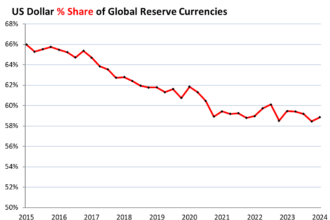

Forex closing April 7, 2025
Updated at 8:01 p.m. on April 7, 2025
MANILA, Philippines — The Philippine peso fell by 1.1 percent on Monday to finish the first trading day of the week back to the 57-level against the dollar, as markets across the world continued to feel the pain from U.S. President Donald Trump’s sweeping tariffs.
The local currency lost 60.9 centavos to close at 57.43 versus the greenback, data from the Bankers Association of the Philippines showed.
The peso’s worst showing stood at 57.45. Trading was also heavy, with funds worth $2.2 billion switching hands.
Michael Ricafort, chief economist at Rizal Commercial Banking Corp., blamed the local currency’s weakness to the panic caused by Trump’s sweeping tariffs on key trade partners of the United States.
“The US dollar-peso exchange rate corrected higher largely due to the continuing effects of Trump’s reciprocal tariffs announced on April 2 that could slow down the US and global economy, with risk of US recession,” Ricafort said.
READ: Asian markets plunge with Japan’s Nikkei diving nearly 8% after the big meltdown on Wall St
Global meltdown
Global stock markets extended a severe plunge Monday, fueled by fears that U.S. tariffs would lead to a global economic slowdown.
European and Asian shares saw dramatic losses, the leading U.S. index flirted with bear market territory in pre-market trading, and oil prices sagged.
The massive sell-off in riskier assets at the start of the trading week follows President Donald Trump’s announcement of sharply higher U.S. import taxes and retaliation from China that saw markets fall sharply Thursday and Friday.
Tokyo’s Nikkei 225 index lost nearly 8 percent shortly after the market opened and futures trading for the benchmark was briefly suspended. It closed down 7.8 percent at 31,136.58.
European shares followed Asian markets lower, led by Germany’s DAX index, which briefly fell more than 10 percent at the open on the Frankfurt exchange, but recovered some ground to move down 5.8 percent in morning trading. In Paris, the CAC 40 shed 5.8 percent, while Britain’s FTSE 100 lost 4.9 percent in the European morning.
Knocking on bear territory
U.S. futures signaled further weakness ahead. For the S&P 500, they lost 3.4 percent, while for the Dow Jones Industrial Average, they shed 3.1 percent. Futures for the Nasdaq lost 5.3 percent.
If the pre-market futures losses materialize when the U.S. market opens, the S&P 500 will enter bear market territory — defined as a fall of more than 20 percent from the peak. The index was off 17.4 percent as of the end of last week.
On Friday, the worst market crisis since the COVID-19 pandemic shifted into a higher gear as the S&P 500 plummeted 6 percent and the Dow plunged 5.5 percent. The Nasdaq composite dropped 3.8 percent.
“There’s no sign yet that markets are finding a bottom and beginning to stabilize,” wrote Deutsche Bank analysts in a research note.
Late Sunday, Trump reiterated his resolve on his decision to introduce tariffs of 10 percent to 50 percent on goods imported into the U.S., a move seen as massively disrupting world trade and supply chains across borders. Speaking to reporters aboard Air Force One, he said he didn’t want global markets to fall, but also that he wasn’t concerned about the massive sell-offs, adding, “sometimes you have to take medicine to fix something.”
Currencies
Exchange rates also gyrated. The U.S. dollar fell to 146.24 Japanese yen from 146.94 yen. The yen is often viewed as a safe haven in times of turmoil. The euro rose 0.3% to $1.0992.
Nathan Thooft, chief investment officer and senior portfolio manager at Manulife Investment Management, said more countries are likely to respond to the U.S. with retaliatory tariffs. Given the large number of countries involved, “it will take a considerable amount of time in our view to work through the various negotiations that are likely to happen.”
“Ultimately, our take is market uncertainly and volatility are likely to persist for some time,” he said. – With reports from AP





















